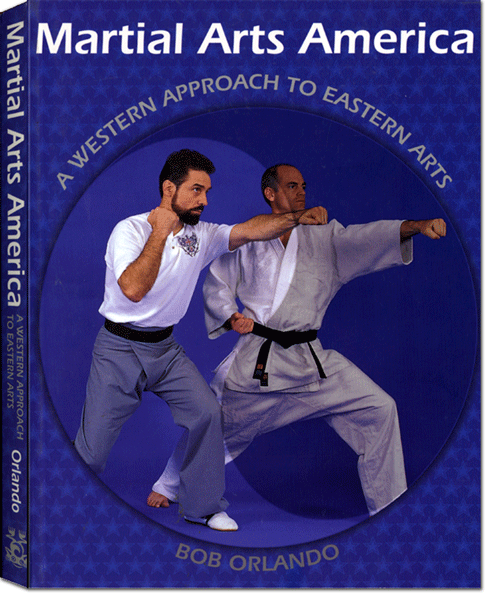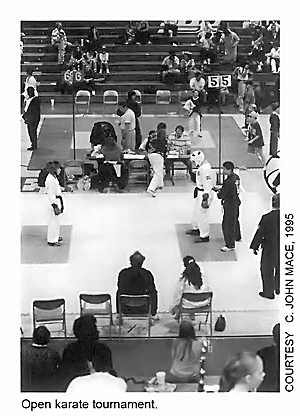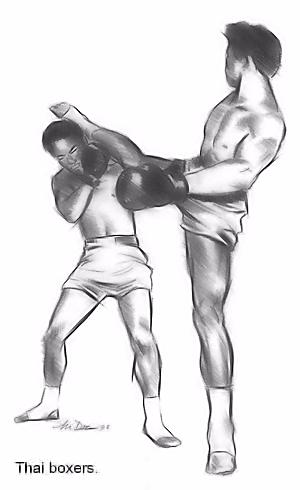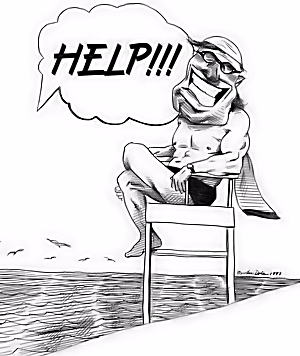
Initially, Funakoshi opposed the idea of a karate tournament. His fear was that the rules necessary to make karate safe for tournament play would also dilute the art, eventually rendering it completely ineffective. Convinced by tournament supporters that tournament play would, instead, help spread the art he loved across the globe, Funakoshi acquiesced, and in 1950 the first large-scale karate tournament was held in Japan.2 Since then, tournament competition and sport karate have taken off, and true to the promises of its proponents, karate is now practiced around the world. But have the great master's fears been assuaged or realized?
The Games Martial Artists PlaySport karate and tournament play are games played by martial artists to display and test some of their skills. Judo has been played in organized competition for long enough that it enjoys the status of being an Olympic event. Tae kwon do is an Olympic demonstration sport, and karate is working hard to earn a spot on the Olympic roster as well.
At the other end of the spectrum are the "full-contact" events. There the emphasis is totally on fighting (no forms or kata). Within the full-contact group there are organizations that use pads and those that do not. Although a few allow kicks below the belt, most do not. Some even allow grappling and wrestling, but for now, in the West, they are in the minority.3 In the full-contact arena, kata competition is not competitive. There it is relegated to minor demonstrations between the major events – the fights. Between these two extremes are a wide range of tournaments that allow and disallow various techniques.
That said, it is important to realize that these games are not for everyone. They are not even necessary to make one a good martial artist. For example, my current instructor has never fought in a tournament in his life (although he has fought for his life on more than one occasion). In more than half a century of training, he has never felt the need to compete. He rarely even participates in public demonstrations. Despite his lack of tournament experience he is, without a doubt, one of the most capable martial artists I have ever come across.4 One of my best friends, on the other hand, has fought in practically every type of sport-karate event there is: full-contact, point karate, good rules, bad rules; sometimes, what even looked like no rules. My friend5 has a win/loss record most of us can only wish for. His success speaks for itself. But my friend has not stopped there. He used his sporting interest as a springboard to developing a depth and breadth of skill in the art that few can claim. His sport successes aside, few will argue that he is anything less than a true martial artist possessing knowledge and skills well beyond his sporting abilities. Looking at the divergent paths of these two men, we can rightfully conclude two things: First, that participation in martial sports is not necessary to be a successful and capable martial artist. Second, that participation in such sport can be an effective vehicle for making one a successful and capable martial artist. This seems to place the competitive aspect of martial arts in the "take it or leave it" category. But deciding to "leave it" may mean missing out on an effective training tool. As martial artists, we are unwise to pass on anything that has the power to make us better. Water Polo Anyone? Originally, tournaments were held for the martial artist, to afford him a legitimate platform to show his skills and test some of them against new opponents and differing styles. Now, however, tournaments are held for just about everyone but the competitor. A few recognized and respected martial artists, like Bill Wallace, are telling us that, "What we've got to think about is spectator appeal. We have to draw more spectators to the art . . . and the spectators do not want all that violence." (Considering the success of "no rules" events like the UFC, it seems that just the opposite is true.) Any tournament run for "spectator appeal" is obviously not being held for the sake of the competitor. What we are told is that the public will not like what attracted us – martial artists – to the art, so we must water it down to a point where they (the spectators) will. The result is a premium paid for ineffective technique, like two-point head kicks and three-point jump kicks, while penalizing what is effective (awarding only one point for punches and eliminating attacks to the groin altogether).
As a martial artist, I have to agree with much of what tournament detractors say. In a growing number of tournaments, the rules are skewed in favor of flashy, high-kicking techniques – high-risk techniques that, if used in the street, make the kicker extremely vulnerable to a leg kick or groin strike. This is especially true on the national circuit. Nevertheless, I still believe that, given the right environment, competitive events are beneficial for the martial artist. For the martial artist, the "right environment" is one that evaluates techniques by their effectiveness, not one that favors one art over another. It is also one that is held primarily for the competitor, not the spectator.
The Value of GamesIf I stop here you might conclude that Master Funakoshi's fears have been realized. I have painted a pretty bleak picture. In light of the importance placed on tournament, trophies, and national ratings, I think the best initial perspective of sport karate is the one you have just seen. However, very little in life is all black or all white, all bad or all good. The same is true of sport karate. There is a good side, a side that benefits the martial artist. To see this, let's examine the subject from two angles. First, let's look at the benefits of free-fighting or sparring (the core of karate competition). After that, we'll look at the benefits of tournament play.Free-fighting Benefits Normally, we avoid those things that will inflame a situation (e.g., you are not standing there in a fighting stance with your guard up at the slightest provocation). But what do you do when you have just been blind-sided? Certainly, there is little doubt then that you are in a fight. No need to worry about escalating a tense situation into a really ugly one; it's already at that stage. Self-defense techniques are little help here because they are, by nature, reactive – you react in response to someone else's action. Most self-defense techniques are taught something like this: "You are standing here and someone does this . . ." Or, "You are in this situation when, suddenly . . . !!" But, when it has already come to blows and you have no choice but to fight your way out. How are you going to take the fight to your assailant? What tactics will you use? Suppose your assailant is a trained tournament fighter. Most tournament fighters train hard. They are in shape, and their skills formidable. Not everything is handled from a stationary position with a simple block and counter. How you enter, move, and cover distance in attack and defense become critical in circumstances like these, and it is here that free-fighting is the most beneficial. But the benefits do not stop there. Sparring also is a great confidence builder. Free-fighting provides the beginning student with a means of self-defense in a relatively short period of time. Normally, competency in any system of self-defense requires years of training. Sparring techniques, on the other hand, are only a small subset of an art's total complement. Being few and relatively simple, sparring techniques require much less time to achieve a minimal level of competence. This superficial level of mastery in a few techniques provides the student with a temporary method of defense until he becomes more proficient in the greater part of the art he studies. Tournament Play This attitude problem is not limited to just the competitors. Too many competitors and spectators alike tend to see tournament fighting as the end – the ultimate demonstration of an individual's martial skill. It may be the ultimate demonstration of skill for those whose arts consist only of sparring techniques tailored for tournaments, but for most martial artists, it doesn't even come close. For the martial artist, viewing fighting competition as anything other than a game and a means to an end is myopic. To believe that tournament play is an accurate reflection of an individual's martial skill is about as accurate as saying all-star professional wrestling is real. This belief in the validity of tournament play as an indicator of one's real skill is probably the main reason many fighting competitors look down their noses at noncompetitors. Competitors often feel that noncompetitors are afraid to put their skills to the test. They believe that the intensity and stress of fighting competition bring one closer to the reality of actual combat than any other form of training. Granted, competition does raise the adrenaline, intensity, and stress levels for the fighter, but what is it about competition that does this? Intensity – Real or Imaginary? Fighting in the school or in the tournament ring, for all its benefits, is still only a game of tag (at least that is what it is supposed to be). As such, an individual's participation and subsequent performance in the ring is in no way a true measure of his or her skill or courage. When it comes to competition, there are those who simply are not motivated to risk a bloody nose, sore ribs, jammed toes, or any other injury for a mere contest. It would be foolish, say, for a dentist – a man who makes his living and supports his family with his hands – to risk injury to those hands in competition. However, I have little doubt that the same individual would willingly risk all, fighting as one possessed, were the safety of his loved ones is at stake. Male grizzly bears are substantially larger than females. As cubs, the males play-fight, but, as adults none of them will take on a female who is protecting her young because she is not play-fighting any more. There are also some schools that legitimately train for nothing but self-defense, using weapons and tactics that are illegal in sport competition – elbows, knees, leg attacks, ground-fighting, and so on.7 Jujutsu is a good example. Excluding the handful of schools that claim to train "only for combat," just so they can tell everyone else how "bad" they are, competitive events for most self-defense schools, either do not go far enough or are simply impractical. Their non-participation, then, is quite reasonable and no reflection on their student's skill or courage.
To Play or Not To PlayFree-fighting, sparring, and tournament play are neither good nor bad in and of themselves. They are, however, only useful when seen, and used, as one tool among many. Competitors and noncompetitors alike need to remember that a hammer should not be the only tool in one's tool box. (You cannot build a house with just a hammer; neither can you build a house without one.) In this respect, both sides have missed the truth.Short of life-and-death (or at the very least, save-your-teeth) fighting, there is no way to develop real combat experience or to test one's fighting spirit. As long as tournaments can be found that offer the martial artist a chance to develop and improve his skills, sparring and competitive fighting will continue to be listed as a benefit for self-defense training, because they do come closest to actual combat – in a relatively safe and controlled environment. (At the very least, you face a moving target.) What sport competitors must avoid is the tendency to view noncompetitors as inferior, unskilled, or lacking courage. Noncompetitors, on the other hand, must recognize that sparring and free-fighting (including competitive play) can be useful training tools. They must remember that many tools are necessary for building a house, or developing a well-rounded martial artist. With this mutual understanding and appreciation, both competitors and noncompetitors will come to respect the truth in the other's position, and sport participation will really grow. So, were Master Funakoshi's fears assuaged or realized? The numbers indicate that there definitely has been growth. According to one source, participation in the martial arts has exploded from 9 million Americans a decade ago to 15 million today. If, however, the numbers increase but the quality of martial artists produced from this growth decreases, then the numbers mean nothing. For myself, I confess that, even after closely examining both sides of this issue, I am less than encouraged at the direction which sport karate seems headed. However, in spite of my misgivings, and despite the many problems inherent in sport karate today, I still believe that we are unwise to dismiss it outright. If nothing else, tournaments do provide the martial artist with a forum for meeting other enthusiasts and exchanging ideas. I continue to make new acquaintances at tournaments and more than a few of them are interesting and capable martial artists. If for no other reason than this, I will continue to support "good" tournaments.
PostscriptSince the writing of this book, sport karate has devolved to a place where all competitors now receive awards – whether they win or not. Sport karate proponents need to recognize that giving every competitor a prize when competing does nothing to improve martial arts. Even though the prize is not deserved, after a while the competitors 'expect' it and it becomes an entitlement that has nothing to do with real accomplishment or achievement. |
|
Footnotes:
|
|
©Copyright Bob Orlando, 1993-2016 All rights reserved. |
http://www.OrlandoKuntao.com
E-mail: Ron@OrlandoKuntao.com |
Last update:
Aug. 6, 2016 by Bob Orlando |




